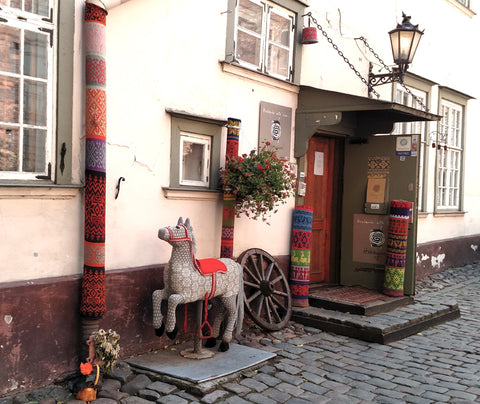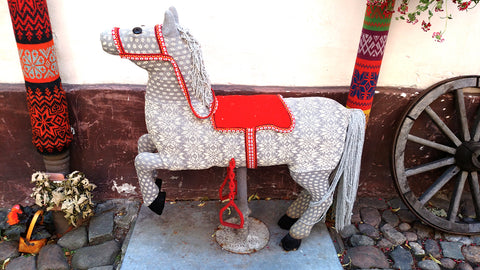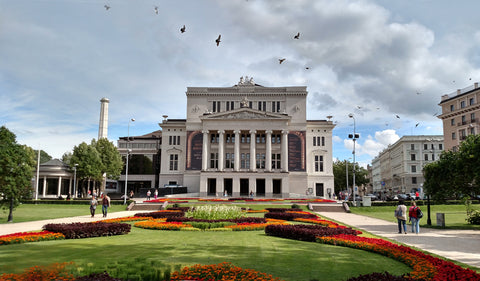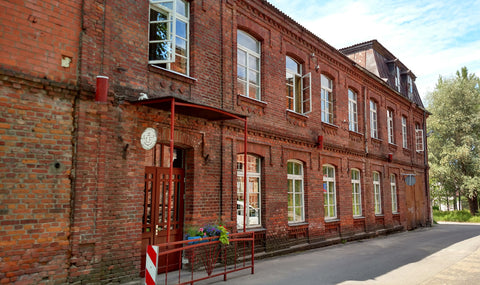The next day was our only full day in Riga. The city was beautiful, but we longed to see more of the countryside. We intended to stroll around the old town, but as we often do, we assigned ourselves a mission, to give direction to our wanderings. One of my favorite ways to explore is to visit all the yarn stores we can manage. This gave us a zigzag route that provided a good sampling of the sights of the old town. We consulted the internet to build a list of places to visit, and in particular found this blog helpful: http://www.kikamoracrafts.com/blog/read_130013/yarn-shops-in-riga-list-of-my-favorites.html. It is written by a local knitter named Laura, who Mike later met when he visited the shop she worked in on our last day in Latvia. (He bought a nice skein of local yarn for me there!)
The old town of Riga is a mix of buildings of many ages, from the founding of the German city in the 13th century into the present day. There are a number of massive churches, expansive squares, old merchant houses, grand Art Nouveau mansions and hotels, and on and on. Most are now in good repair, and the city offers, at least on a summer’s day, a bright, welcoming aspect. It is popular with tourists, but unlike Tallinn, didn’t feel overwhelmed by them.
Two of the yarn shops we visited stood out. The first is the famous Hobbywool, already well known to fans of Latvian knitting. We fingered lots of Latvian made wool, and eyed their “Knit Like A Latvian” kits. The shop is in a little alley which is VERY “yarn bombed!” I especially liked their mascot, a carousel horse fully covered in a knitted skin.

Entrance to Hobbywool

The yarn-bombed horse at the Hobbywool door
The shop that really made my heart go a-flutter was called Dzijas, which just means “yarn” in Latvian. It lies a little out of the old town, down a crooked little staircase in a basement; very obscure and a little hard to find. Once there, though, we found a small room crammed floor to ceiling with yarn of all kinds of colors, much of it unlabeled, with an opaque organization. The proprietress, however, knew every skein she had, and where to find it. It is one of those shops with just a single, narrow path through all the merchandise, and barely room for more than a couple of customers at a time. I was in heaven…and though tempted, only bought a small amount of lovely mohair silk for a future lace shawl. The absolutely gorgeous fine pearl cotton from Russia with an amazing array of colors and very reasonable price was hard to leave behind. It would have been perfect for weaving, but, alas, cotton is very heavy and we didn’t have much leeway in terms of airport rules.
After escaping from Dzijas without too much damage to the pocketbook, we crossed back over the old moat, and through the park that traces the old line of fortifications. We lingered in front of the beautiful Opera House, with its formal garden setting. Alas, nothing was playing there during our visit. We then climbed Bastion Hill for the view, and wandered back to our hotel for an afternoon break.

Riga Opera House

View of the Independence Monument from Bastion Hill
For dinner that night we went just a few doors up from our hotel to the 1221 Restaurant, considered one of the best in Riga. The name comes from the date of the building housing the restaurant, one of the oldest surviving in the old town. It was apparently built for the founder of the brotherhood of beaver hunters. We had a fine meal of modern interpretations of traditional Latvian cuisine, and watched with pity as the servers negotiated four flights of stairs to carry plates up to the rooftop terrace (we were on the second level). One has to be fit to work in this restaurant! Among the menu items that we sampled there were duck confit with black current-chocolate sauce with fresh currents and asparagus and a wonderful and quite unique pumpkin seed ice cream with chestnut orange sauce and balsamic cherries. This is the only place we’ve ever seen smoked beaver meat on the menu, although we didn’t choose to sample it.
After dinner, we took a stroll through another corner of old town, and came upon a building in the process of demolition. The façade was braced and left standing (which I would guess is required for historical preservation) while the interior was gutted. This was on a small street where, unlike most of the rest of the old town, the buildings were not so well maintained. We guessed they were all due to be modernized soon.
As we made our way back to our hotel, we could see that the neighborhood bars and restaurants were filling up with young people, most of them watching the EuroCup soccer match. The nightlife was coming alive, just like it might in Seattle’s oldest neighborhood, Pioneer Square, and countless other historic quarters in modern cities.
The road south from Pärnu was less scenic than we hoped, since it is inland from the seashore, and screened on both sides by trees. This is a highway, the main route between Tallinn and Riga, so it was busier and faster moving than most of the roads we had been on. Soon we came to the border with Latvia, which had an inspection station for commercial trucks, but which we just drove through.
Our first stop in Latvia was at the Randu Pļava, or randu meadows. This is a nature reserve protecting an area of seaside meadows, home to many rare plants, as well as more species of birds than anywhere else in Latvia. A short walk through the woods took us to the meadows, covered in tall grass and wildflowers. Boggy spots kept us from approaching the beach itself, and the boardwalk out to the birdwatching tower was unfortunately deteriorated and impassable, but it was a good introduction to a bit of unique Latvian nature. Ilga had a less welcome nature experience here, with her first encounter with Latvian mosquitos.
Continuing south, we felt the urge to get off the busy coast road, so we turned up the P11 towards Limbaži. (The P roads in Latvia are secondary, but paved roads, a step down from the A roads, which are major highways. Freeways as we know them in the USA don’t really exist in Latvia. We always looked for routes on the P roads when we could, to enjoy the quieter pace. Roads out in the countryside that don’t have an A or P designation are often unpaved). We picked Limbaži as a destination because we had read of a felt museum there. We found our way to the local tourist office there for more information.
The Limbaži tourist information office was our first encounter with this very nice bit of tourist infrastructure in Latvia. Every town of size has one of these offices, and they are amply stocked with brochures and maps of all kinds, covering all sorts of interests, generally in at least three languages (Latvian, Russian and English), and often more. In most places at least some of the staff was conversant in English as well as other languages. Limbaži was not one of them, however, so Ilga had to make her first effort to remember her childhood language.
Beyond the language barrier, the staff had no idea what the felt museum might be. Eventually we all came to realize that the internet listing was referring to a large felt factory that had operated in the town for nearly 100 years. One of the old factory buildings was now a community center, and had a small display about the history of the factory complex. The tourist office staff pointed us in the direction of the community center, and called down to let them know these crazy American tourists were coming.

The Limbaži felt factory, now a community center
The director of the center was a very pleasant middle-aged woman, whose English more or less matched Ilga’s Latvian. She explained the history of the building to us. It had at one point been a very large operation, making felt for the hat trade, and making hats as well, but it had closed down 30 years ago. The community center was an effort to repurpose at least one building. It now served kids and adult, with classes ranging from knitting to yoga. Alas, if the director had known we were coming, she would have arranged for the viewing of a film about the factory. Other disused factory buildings, all of red brick, sat scattered around the area, reminding us of other decaying old mill towns we have seen both domestic and foreign.
The director mentioned that there was a woolen mill with an attached store in town, and directed us further down the street to the small shop. Ilga chatted with the shopkeeper, and asked if it was possible to see some of the mill. Sure, why not? The manager himself came out, and gave us a tour of the full operation, from blending the wool through spinning and dyeing to weaving, some of it on truly antique machinery. Alas, since we left our car up the hill and were herded from one place to another (all quickly before closing time), we didn’t have a camera with us.
The first step in the process is mixing the native, somewhat coarse, domestic Latvian sheep’s wool with a small percentage of very short fine wool. (Most current Latvian sheep are a black-faced, long-tailed, polled breed which originated from the crossing of Shropshire sheep (72%) and Oxfordshire sheep (28%) during the 1930’s). This blending (including wool for the grey yarns favored for woolen socks) is done by hand. This is then further blended on a giant drum with very long, coarse teeth. It is measured for the next stage (a run of large six foot drum carders) by a very simple weight calibrated bin which, when full, dropped the wool onto the conveyor. The wool went through three sets of 6 foot drums, being thinned into finer roving between each drum. The end result was a tiny diameter pin roving (about 1/8th of an inch at most). Wrapped onto large 4 foot spools about a foot thick, these were taken to the spinnerets where the wool was spun onto large half meter bobbins. These were then taken to the plying machines. The mill produces 1, 2, and 3 ply yarns. The yarn is then washed and dyed with Swiss ecologically safe dyes, and finished in a steam chamber.
There are also several weaving rooms in the building. The large “commercial” looms were for Limbazu Tine’s characteristic striped wool blankets. We watched a woman winding the bobbins for the large fly shuttle looms, while the looms clattered (under supervision) behind us. The finest work of this small factory is their Latvian ethnic costume yardage, complicated hand-loomed pieces. Many of these are multi-harness, supplementary warp fabrics woven for the regional folk costumes. They also do beautiful multi-harness table clothes and linens. The blankets are heavily fulled which left them extremely soft and fluffy from fairly flat and coarse fabric. It was an eye-opening transformation and learning experience for me. I’ve fulled hand-woven fabric, of course, but never as brutally with such beautiful results.
We were amazed at the generosity of the manager, spending over an hour with these random visitors, but it wasn’t the last time that we encountered such accommodation from people when we showed interest in their work. Since we didn’t take pictures, I searched the internet and found this video about the mill. You can see some of the equipment and the weaving rooms. The sewing project near the end of the video is about their solution for making a banner with EVERYONE attending the exhibit would be able to contribute. Stitching in “God Bless Latvia” was easier than teaching everyone to weave. The video also gives you an idea of how Latvian sounds, even if you can’t understand it!
https://www.youtube.com/watch?v=TX2w517lKHA
And here are a couple of pictures of some of their wares, for those who don’t want to watch the video:

Products of the Limbaži wool factory

Weaving by the Limbaži wool factory
Eventually it was time for us to go, to meet our 6pm deadline for returning our rental car, so we hustled down the road towards Riga. The countryside was beautiful, lit up by late afternoon light, as we drove by farms and fields. Unlike the seemingly uninhabited Estonian country, here we saw the sort of signs of life we expected – herds of cattle, kitchen gardens, tended orchards, frequent farmhouses.
Arriving in Riga (and readjusting to heavy traffic), we dropped our car off at a hotel drop site in the new town with just 10 minutes to spare., Automobiles are restricted and sparse in the old town, so a taxi was our mode of transport to the hotel . Our room was spacious but somewhat oddly laid out, and the air conditioning couldn’t keep up with the demands of being right under the roof on a hot sunny day. It was comfortable enough, though.
After settling in, we strolled out looking for a likely restaurant for dinner, with nothing particular in mind. The old town in Riga is a center of night life, with many bars and restaurants, so we knew we would find something. We happened upon Rozengrals, a medieval themed restaurant, located in the oldest existing wine cellar in Riga. They had gone all out on the theme, with the staff in costumes, wandering minstrels, and authentic medieval recipes. Most of the lighting was provided by candles. Mike asked our server how they cleaned the place, and she said they had to break out headlamps! It was a fun meal, and a good end to our first day in Riga.
Here’s a virtual tour from the street into the vaulted main room of the restaurant. Included with the video tour is some of the wonderful music that was played by the musicians during our meal. (Look for the yellow arrow to go downstairs.) I had a poultry liver salad with bacon and almonds as an appetizer which was SPLENDID and so much better than it sounds. Ilga had spit fired piglet and Mike had smoked curried brandy chicken.
http://www.virtuallatvia.lv/Tours/Rozengrals/Tour.html







